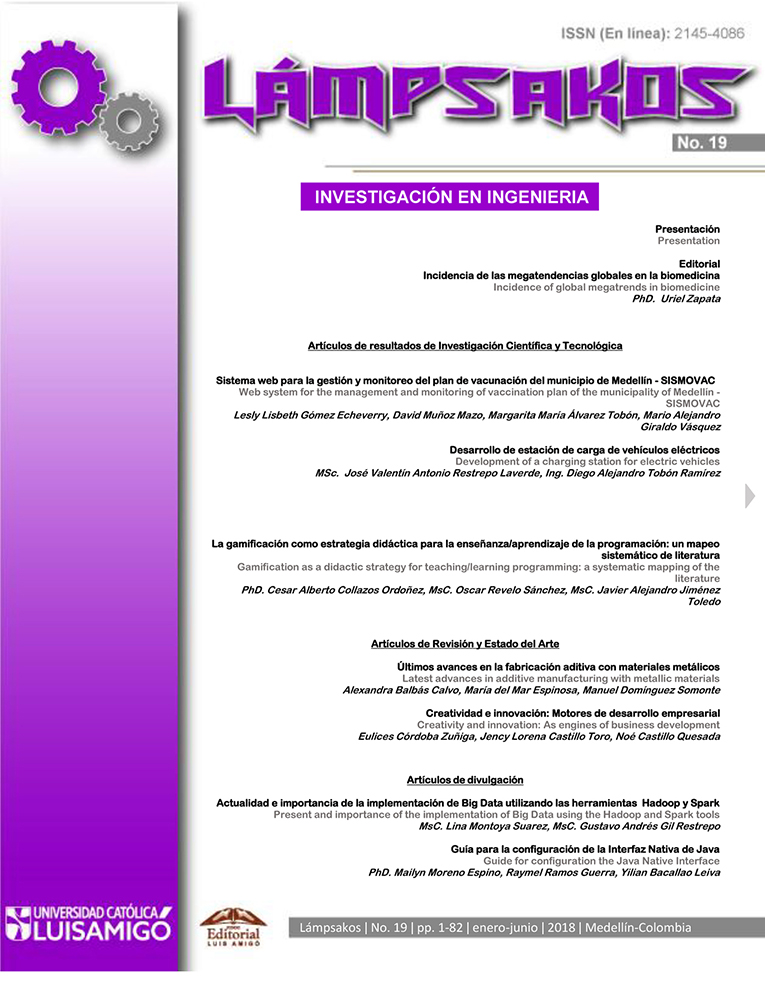Guide for configuration the Java Native Interface
DOI:
https://doi.org/10.21501/21454086.2344Keywords:
Eclipse, Framework, JNI, Java Virtual Machine, Visual StudioAbstract
Currently there are several programming languages and it is necessary to have a tool that allows integration between them. Java provides a framework called: Java native interface, JNI; to allow it to be written in languages other than Java and maintain portability across all platforms. It allows the code running on the Java virtual machine to interact with applications and libraries written in other languages, such as C, C ++ and assembler. This manual is based on a basic example of a "Hello Word" application, which serves the simple way, shows the steps to follow for the JNI configuration in the development environments involved, which for this guide were, for Java: Eclipse and for C ++: Visual Studio 2010.Downloads
References
P. Deitel and H. Deitel, Java How to Program: Prentice Hall Press, 2011.
O. B. Fernández, Introducción al lenguaje de programación Java.: Una guía básica vol. 9, 2005.
R. McNab and F. Howell, "Using java for discrete event simulation," in Proceedings of the Twelfth UK Computer and Telecommunications Performance Engineering Workshop, 1996, pp. 219-228.
S. Stricker. (2002, Java programming with JNI. Developer works, 22.
D. G. Javier and R. J. Ignacio, "Aitor, Imaz," Aprenda Java como si estuviera en primero. Escuela Superior de Ingenieros Industriales. San Sebastian, 2000.
S. Liang, The Java Native Interface: Programmer's Guide and Specification: Addison-Wesley Professional, 1999.
L. F. Evgeniy Gabrilovich, "JNI – C++ integration made easy," 2007.
Downloads
Published
How to Cite
Issue
Section
License
In accordance with national and international copyrights, as well as publishing policies of "Fundación Universitaria Luis Amigó" and its Journal "Lámpsakos" (indexed with ISSN : 2145-4086), I (we ) hereby manifest:1. The desire to participate as writers and submit to the rules established by the magazine publishers.
2. The commitment not to withdraw the manuscript until the journal finishes the editing process of the ongoing issue.
3. That article is original and unpublished and has not been nominated or submitted together in another magazine; therefore, the rights of the article in evaluation have not been assigned in advance and they do not weigh any lien or limitation for use.
4. The absence of conflict of interest with commercial institution or association of any kind
5. The incorporation of the quotes and references from other authors, tending to avoid plagiarism. Accordingly, the author affirms that the paper being published do not violate copyright, intellectual property or privacy rights of third parties. Morover, if necessary there is a way of demonstrating the respective permits original copyright to the aspects or elements taken from other documents such as texts of more than 500 words, tables, graphs, among others. In the event of any claim or action by a third party regarding copyright on the article, the author (s) will assume full responsibility and come out in defense of the rights herein assigned. Therefore, for all purposes, the Journal "Lámpsakos" of the "Fundación Universitaria Luis Amigó" acts as a third party in good faith.
6. In the event of the publication of the article, the authors free of charge and on an exclusive basis the integrity of the economic rights and the right to print, reprint and reproduction in any form and medium, without any limitation as to territory is concerned, in favor of the Journal "Lámpsakos" of the "Fundación Universitaria Luis Amigó".








